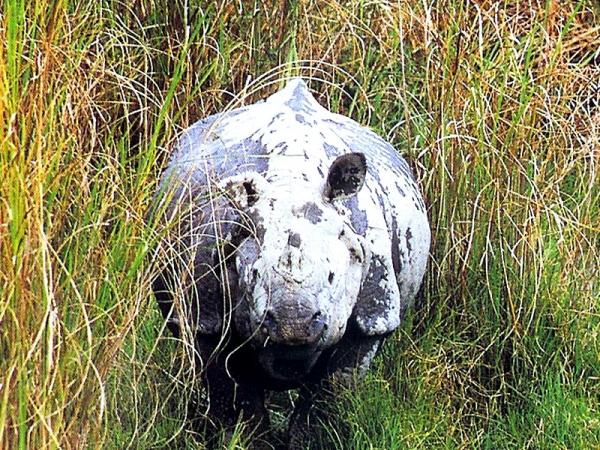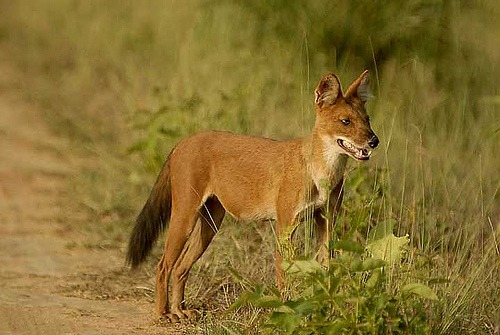Environment & Ecology: Endangered Species
Endangered Species
- An endangered species is a type of organism that is threatened by extinction.
- A plant or animal species existing in such a small number that it is in danger of becoming extinct, especially such species placed in jeopardy as a result of human activity. One of the principal factors in the endangerment or extinction of a species is the destruction or pollution of its native habitat. Other factors include over hunting, intentional extermination, and the accidental or intentional introduction of alien species that out compete the native species for environmental resources.
The causes of endangerment
- Endangerment is a broad issue, one that involves the habitats and environments where species live and interact with one another.
- Although some measures are being taken to help specific cases of endangerment, the universal problem cannot be solved until humans protect the natural environments where endangered species dwell.
- There are many reasons why a particular species may become endangered.
- Although these factors can be analyzed and grouped, there are many causes that appear repeatedly.
- Given below are several factors leading to endangerment:
Habitat Loss
- Our planet is continually changing, causing habitats to be altered and modified.
- Natural changes tend to occur at a gradual pace, usually causing only a slight impact on individual species.
- However, when changes occur at a fast pace, there is little or no time for individual species to react and adjust to new circumstances.
- This can create disastrous results, and for this reason, rapid habitat loss is the primary cause of species endangerment.
- The strongest forces in rapid habitat loss are human beings. Nearly every region of the earth has been affected by human activity, particularly during this past century.
- It can be difficult for an individual to recognize the effects that humans have had on specific species.
- It is hard to identify or predict human effects on individual species and habitats, especially during a human lifetime. But it is quite apparent that human activity has greatly contributed to species endangerment.
Introduction of Exotic Species
- Native species are those plants and animals that are part of a specific geographic area, and have ordinarily been a part of that particular biological landscape for a lengthy period of time.
- They are well adapted to their local environment and are accustomed to the presence of other native species within the same general habitat.
- Exotic species, however, are interlopers.
- These species are introduced into new environments by way of human activities, either intentionally or accidentally.
- These interlopers are viewed by the native species as foreign elements.
- They may cause no obvious problems and may eventual be considered as natural as any native species in the habitat.
- However, exotic species may also seriously disrupt delicate ecological balances and may produce a plethora of unintended yet harmful consequences.
- The worst of these unintended yet harmful consequences arise when introduced exotic species put native species in jeopardy by preying on them.
- This can alter the natural habitat and can cause a greater competition for food.
- Species have been biologically introduced to environments all over the world, and the most destructive effects have occurred on islands.
- Introduced insects, rats, pigs, cats, and other foreign species have actually caused the endangerment and extinction of hundreds of species during the past five centuries.
- Exotic species are certainly a factor leading to endangerment.
Over-exploitation
- A species that faces over-exploitation is one that may become severely endangered or even extinct due to the rate in which the species is being used.
- Unrestricted whaling during the 20th century is an example of over-exploitation, and the whaling industry brought many species of whales to extremely low population sizes.
- When several whale species were nearly extinct, a number of nations (including the United States) agreed to abide by an international moratorium on whaling.
- Due to this moratorium, some whale species, such as the grey whale, have made remarkable comebacks, while others remain threatened or endangered.
- Due to the trade in animal parts, many species continue to suffer high rates of exploitation.
- Even today, there are demands for items such as rhino horns and tiger bones in several areas of Asia. It is here that there exists a strong market for traditional medicines made from these animal parts.
Other Factors
- Disease, pollution, and limited distribution are more factors that threaten various plant and animal species.
- If a species does not have the natural genetic protection against particular pathogens, an introduced disease can have severe effects on that specie.
- For example, rabies and canine distemper viruses are presently destroying carnivore populations in East Africa.
- Domestic animals often transmit the diseases that affect wild populations, demonstrating again how human activities lie at the root of most causes of endangerment.
- Pollution has seriously affected multiple terrestrial and aquatic species, and limited distributions are frequently a consequence of other threats; populations confined to few small areas due to of loss of habitat, for example, may be disastrously affected by random factors.
Protection of endangered species at National level
- Endangered species in India comprise large varieties of rare species of wild animals, aquatic animals and insects.
- Indian wildlife consists of numerous species of birds, mammals, reptiles etc, and is well known for comprising one of the richest varieties in the world.
- The Indian wildlife also contains several endangered species that are living critically on the verge of extinction.
- An endangered species is defined as a population of a living being that is at the danger of becoming extinct because of several reasons.
- Either they are few in number or are threatened by the varying environmental or predation parameters.
- The endangered species in India have been identified by different national and international organizations like the World Wildlife Fund (WWF), International Union for Conservation of Nature and Natural Resources (IUCN) and the wildlife institute India (WII).
Statistics of Endangered Species in India
- As per the official records, in India, there are over 1.30 Lacs endangered animal species, although some experts believe that the number may be even more than the projected figures.
- However, some claim that the number is actually much more.
- The number of endangered species in India accounts for around 8.86 % of the world`s mammals.
- The mammals are extended over 186 genera, 45 families and 13 orders out of which around 89 species are listed as threatened in the IUCN Red List of Threatened Animals (IUCN 2006).
Types of Endangered Species in India
The endangered species in India have been divided into 4 main categories.
- Critically Endangered (CR)
- Endangered (EN),
- Vulnerable (VU) and
- Threatened.
This classification was done by the International Union for Conservation of Nature and Natural Resources (IUCN) and Wildlife Institute of India (WII), in the year 2004. The population of the endangered species has been decreasing with the passing time.
Critically Endangered and Endangered Species in India
- Among the endangered species in India, one of the most critically endangered one is the Siberian Tiger.
- Another endangered species in India is one of the big cats, the Golden Leopard with black marks.
- The number of this species has been reduced to as low as 14,000 in India.
- The main reasons behind the decline of Leopard population in India have been the loss of habitat and also human population pressure on wildlife reserves in India.
- These reasons are also a matter of great concern for the other endangered species in India.
- The major reason behind the habitat loss is the spread of agriculture.
- The Royal Bengal Tigers were also extensively being captured for pet trade, zoos and research, as well as for use in Oriental medicine, in the past.
Some more critically endangered species
- India is home to very diverse and rich wildlife which includes over 172 endangered species.
- A great deal of effort has been made in the last sixty years to preserve the natural habitats as well as the population of the wildlife across the Indian landscape.
- With the encroachment of human activities on these lands, the natural habitat has been destroyed and has shrunk considerably.
- This has endangered not only the smaller avian, reptile and mammal‘s population but also eroded endemic flora and fauna.
Actions/Laws for Wild Life Conversation Chronologically:
3 BC – The earliest codified laws can be attributed to King Ashoka, who in his decrees engraved on edicts, prohibited the killing of certain species of animals.
1873 – The Madras Act was passed to prevent the indiscriminate destruction of wild elephants. This was the first Act under the British regime for regional protection of wild life.
1887 – The Wild Birds Protection Act of 1887 was passed which enabled the British government to frame rules prohibiting possession or sale of any kind of specified wild birds only during breeding Season. Also this Act was only applicable to those areas, which were under the control and supervision of Municipalities and cantonments under the British regime.
1912 – The Wild Birds and Animals Protection Act of 1912 was passed. For the first time, a codified law was enacted prohibiting the killing and capturing of wild animals and the disobedience of which entailed a penal offence. The Act was also comprised scheduled animals, which listed birds and animals which could not be killed, captured or sold.
1935- The Wild Birds and Animals Protection Act No 27 of 1935 was enacted. This was a land mark year in the history of wild life as it was for the first time that the provincial government, could by notification, set aside an area to be a sanctuary for protection and growth of wild animals and birds.
1935- This year also witnessed the passing of the government of Indian Act 1935 in which the legislative powers were distributed between federal and provincial legislatures. The Protection of Wild Birds and Wild Animals was entrusted to the provincial legislature vide Entry 25 of the State List.
1952- The first wildlife authority, in the form of an advisory board, was set up in 1952 called the Central Board for Wild Life renamed as Indian Board for Wildlife.
1972- The Wild Life protection Act 1972 (Act No 53 of 1972) was passed. It was the first comprehensive Act passed for the protection of wild animals. However, subject to licences, hunting was permitted for certain purposes such as special, big and small games. Further the Act also permitted trade of trophies of scheduled animals under a licence.
1973- The project Tiger‘was launched. Subsequently, several other schemes were initiated for protection of specific habitats and to save threatened species such as the Asiatic Lion in Gujarat, Barasigha in Madhya Pradesh, Hangul in Kashmir and many more.
1976 - The constitution (forty-second Amendment) Act 1976 was passed in which art 48A was Inserted in the Directive principles of state policy, which read as under – The state shall Endeavour to protect and improve the environment and to safeguard the forests and Wildlife of the country‘ A separate chapter IVA was incorporated where art 51A (g) states –Its shall be the duty of every citizen of India to protect and improve the natural environment including forests, lakes, rivers and wildlife and to have compassion for living creatures‘ Also the protection of wild animals and birds was transferred as 17B in the concurrent list of the constitution.
1976- Ratification of the convention on International Trade in Endangered species of Wild fauna and flora (CITES) by India on October 18.
1976/77- A separate Directorate of wildlife Education and Research was established.
1980- The Forest conversation Act 1980 was passed, which is inter alia, also aimed to preserve the natural habitat of Indian wildlife.
1982- In the Amendment Act No 23 of 1982, sections 11 and 12 of wild life Act 1972 were amended which permitted the capture and translocation of wild animals for scientific management and introduction of endangered species in alternative suitable habitat. The licensing practice for carrying out business in trophies and an animal article was also amended in Section 44 of the WLPA.
1982- The Wildlife Institute of India was established whose prime objective was to provide a professional and scientific support to the management and development of wildlife in India.
1983 –The National Wildlife Action plan was adopted by the Indian board for wildlife which was inspired by the World Conversation strategy and the Bail Action Plan. The Chairperson of IBWL, Smt. Indira Gandhi, the then prime Minister of India, outlined a board framework and strategy for wildlife preservation of India.
1986- A Major step was taken to enforce the provision of CITES under art 253 of the Constitution of India. A separate Chapter V-A was inserted in the WLPA, which prohibited trade and commerce in trophies, animal articles derived from animals listed in the scheduled of the Act.
Critical analysis of Position in India
- India is a home to very diverse and rich wildlife which includes over 172 endangered species.
- A great deal of effort has been made in the last sixty years to preserve the natural habitats as well as the population of the wildlife across the Indian landscape.
- The Bengal tiger, Asiatic water buffalo and Indian elephant are just some of the magnificent animals walking the plains and tropical rain forest across India.
- It is amazing to see the herds migrate from jungle to jungle in order to sustain their population in a good and natural habitat. With the encroachment of human activities on these lands, the natural habitat has been destroyed and has shrunk considerably.
- This has endangered not only the smaller avian, reptile and mammal’s population but also eroded endemic flora and fauna.
- Wildlife in India is considered sacred to the culture and heritage of the country.
- A great deal of effort has been made in collaboration with international environmental protection and wildlife conservation organizations to ensure the safety of the natural habitat of Indian wildlife.
- Unfortunately agricultural land has been given the priority and the natural habitat has been eroded to make way for human occupation.
- As human encroachment and settlement increased across the Indian landscape, the wildlife was cornered in specific areas.
- These were eventually declared as protected and endangered areas.
- Once this status was awarded to a particular area or breed of animal or species of bird, a great deal of effort was maintained to prevent the poaching and hunting of wildlife.
- This helped in increasing the awareness and subsequently the population of endangered and exotic species.
- There are quite a few sanctuaries, for example the ones in Gujarat, Jammu and Kashmir, Kerala, Goa and Madhya Pradesh among others.
- A good thing about the network of Wildlife Protection in India is that there is one basic administration that runs the Forestry and Wildlife Department.
- It has different subsets in each state and the Central Government acts as the main advisory to each of these divisions.
- The creation of the Wildlife Protection Act has made it mandatory for each union territory to have wildlife advisory boards.
- Furthermore, with the addition of wildlife preservation in the Constitution the situation has greatly improved in terms of safeguarding wildlife populations across India.
- With the use of information and experience of international wildlife protection agencies like the World Wildlife Federation which has placed 172 species on the endangered animal list in India, the total number of national parks and sanctuaries has risen from 5 parks to 104 national parks.
- Further, the number of sanctuaries has increased from 60 to 531 parks in the last decade.
- Another interesting fact about the sanctuaries and parks for conserving wildlife in India is that they are distributed throughout the Indian landscape and even on some islands.
- The biodiversity in India is spread across plains and mountains along with the plateaus and coastal areas.
- Each of these areas has been given full attention and therefore resulted in the creation of safe havens for aquatic and land populations of endangered species across India.
- From crocodiles to Tigers and elephants to peacocks there are many species which are protected under the national conservation projects across the country.
Most Endangered Wild Animal Species of India
1.Indian Tiger

- The All members of Felide family, which includes three great cats Asiatic Lion, Bengal Tigers, wild cats and leopard, found in India are not in the so good population, Because of the excessive poaching, big cats in India are on the verge of extinction.
- There is only 1411 Royal Bengal Tiger left in India, Asiatic or great India lion only found in Gir national park.
- One of the most endangered species of felide family is snow leopard, found only in Himalaya Ranges.
- Snow leopard along with another felide member clouded leopard are the two highly endangered species of big cats found now only with great range of Himalayas.
2.Ganges Dolphin

- The Ganges River Dolphin is member of Cetacea family,which includes marine mammals porpoises and whales. Dolphins primarily found in the Ganges and Brahmaputra Rivers and their tributaries in India. They share their habitat with crocodiles, fresh water turtles. The blind Dolphin of holy river Ganges is the National Aquatic Animal of India.
- The India Rive shark is also listed as one of the endangered Species in India.
3.Gharial

- The gharial is one of the three crocodilians found in India the longest of all living crocodilians.
- The holy river Ganage is one the most habitat of the Gharial in India,the king of rivers also found in Chambal,Irrawady and Brahmaputra rivers.
- The gharial is listed as a most critically endangered species in India.
- Mass Gharial Deaths in Chambal river is still a mystery, one of the major cause is “polluted river water”.
4.Indian Bustard

- The Great Indian bustard is one of the world’s heaviest flying birds is one of such rarest birds of Indian Sub-continent.
- The Bird is found only in some parts of Gujarat, Maharashtra, and Rajasthan.
- Less than a thousand survive today and the species is threatened by hunting and loss of its habitat.
- Indian Vulture is another endangered birds of India, vultures were being found dead and dying throughout India.
- Indian King Vulture found sharply in Gujarat, Rajasthan and Uttar Pradesh.
5.Indian Rhinoceros

- The Great Indian Rhinoceros also called as One Horned Rhinoceros found in India.
- The Indian Rhinoceros has a single black horn which is present in both male and female species.
- The Great Indian Rhinoceros is the fourth largest animal in the world.
- The large endangered mammal is primarily found in parts of north-eastern India, Today about 3,000 rhinos live in the wild, 2,000 of which are found in Manas and Kaziranga National Park Excessive hunting for its horn reduced their natural habitat drastically.
6.Indian Wild Dog

- Indian Wild Dog or Dhole is one of the top predators of wild forest,living in packs, hunting cooperatively and highly social animals.
- An Asiatic wild dog is also called the whistling hunter, because it has an extraordinary vocal call.
- Dhole is found in national parks of Assam, Bengal, Gujarat, Kashmir, Madhya Pradesh, and Nilgiri Biosphere reserve of south India.
- It is estimated that only 2500 Dholes are left in the wild.
- Threats to the dhole species include habitat destruction and loss of its main prey.
- There is a documentary available in Nat Geo as “The PACK”, which was one of the best documentary ever made on Asiatic wild dogs.
7.Red Panda

- The beautiful and endangered species,Indian Red Panda is also known by the name of Red Fox.
- From the two kinds of Red Pandas in the world, only one variety is found in India.
- India has 20 protected areas with Sikkim, Arunachal Pradesh and West Bengal’s Khangchendzonga and Namdapha National Park.
- The endangered Red Panda live in temperate climates, in deciduous and coniferous forests, usually with an under story of bamboo and hollow trees.
Approval for the Trishna Gas project of ONGC which falls in the Trishna Wildlife Sanctuary
- The National Wildlife Board has given its approval for the Trishna Gas project of ONGC which falls in the Trishna Wildlife Sanctuary in the Gomati district of Tripura.
- ONGC has discovered 10-12 gas bearing wells in the Trishna Wildlife sanctuary. Oil and Natural Gas Corporation (ONGC) Tripura Asset would soon start extracting natural gas from Trishna Wildlife Sanctuary in Belonia subdivision of Gomati district following National Wildlife Board’s clearance of its proposal.
- The gas extracted from Trishna Wildlife Sanctuary would be transported to the North Eastern Electric Power Corporation Ltd (NEEPCO) owned 100 MW gas-based thermal power project at Monarchak in Sonamura subdivision of Sipahijala district.
Trishna Wildlife Sanctuary
- Trishna Wildlife Sanctuary is a Wildlife Sanctuary in Tripura, India.
- It covers an area of about 163.08 square kilometers. This sanctuary is situated in South Tripura District.
- This sanctuary has a number of perennial water rivulets, water bodies, and grass land. Indian Gaur (Bison) is an attraction of this sanctuary.
- Apart from it, there are varieties of Birds, Deers, Hollock Gibbon, Golden Langur, Capped Langur, Pheasant and many other animals and reptiles.
Nilgiri Tahr: Climate change threatening 60% of its habitat
Context
- A new study has predicted that most of the existing habitats of the Nilgiri Tahr (species of wild mountain goat) in the Western Ghats will become unsuitable as global warming intensi?es.
Study Analysis:
- Historically, the Nilgiri Tahr was found everywhere in the Western Ghats.
- Currently only 3,000 exist and their habitat is restricted to one-tenth of their original range. And they are found only in the southern Western Ghats in an altitude range of 1,100 metres to 2,600 metres.
- The study suggested that Kalakkad Mundanthurai Tiger Reserve in Tamil Nadu and the Peppara, Neyyar Schenduruny and Srivilliputhur wildlife sanctuaries in Kerala and Tamil Nadu will become unsuitable for the Tahr in the future due to climate change.
- It predicted a maximum habitat loss of 61.2 per cent, 61.4 per cent and 63 per cent for 2030, 2050 and 2080 respectively if emissions did not reduce.
- The study also forewarns that the existing protected area network might not be effective in conserving the Tahr if climate mitigation measures are not adopted in management plans of protected areas.
- The study recommends surveys for improving the condition of existing habitats.
Other Threats:
- Agriculture & aquaculture: Annual & perennial non-timber crops, Livestock farming & ranching.
- Biological resource use: Hunting & trapping terrestrial animals.
- Invasive and other problematic species, alien species, genes & diseases
Nilgiri Tahr:
- IUCN Redlist Status: Endangered
- Habitat And Ecology: Grassland, Shrubland, Rocky areas (eg. inland cliffs, mountain peaks)
- They are known as Pride of Munnar.
- Found in the tourism zone of the Eravikulam National Park (ENP) near Munnar.
Swelling Salinity Threatens Gangetic Dolphins
Context
Five year study in Sundarbans region has found that rising water salinity is threatening the habitat of Gangetic dolphins.
Threat Analysis:
- Study highlighted that earlier in 1879; these freshwater loving mammals swam along the entire length of Ganga and Brahmaputra and all of their tributaries. From the delta of Bay of Bengal up to the Himalayan foothills.
- Today at the merging of Ganga, Brahmaputra and Meghna which form the Sundarban region, these dolphins struggle to survive.
- India’s “Dolphin Man” Ravindra Sinha has observed that water diversion, commissioning of large barrages upstream has impacted the salinity pro?le of rivers downstream in central sundarbans.
- Declining ?ow of Ganga is the biggest threat to Gangetic dolphins along with water intensive agriculture in the basin.
- Bihar constitutes 50% of mammals in the country. India’s only protected area for Gangetic dolphins are at Vikramshila Gangetic Dolphin Sanctuary in Bihar.
- Asia’s First National Dolphin Research Centre is coming up in Patna to give boost to research and conservation of dolphins.
Other Threats:
- Biological resource use: Fishing & harvesting aquatic resources,
- Natural system modi?cations: Dams & water management/use
- Pollution: Industrial & military ef?uents, Agricultural & forestry ef?uents
NAG missile

PUNCH

Mosaic Mission

AROGYAPACHA

RISAT-2BR1



